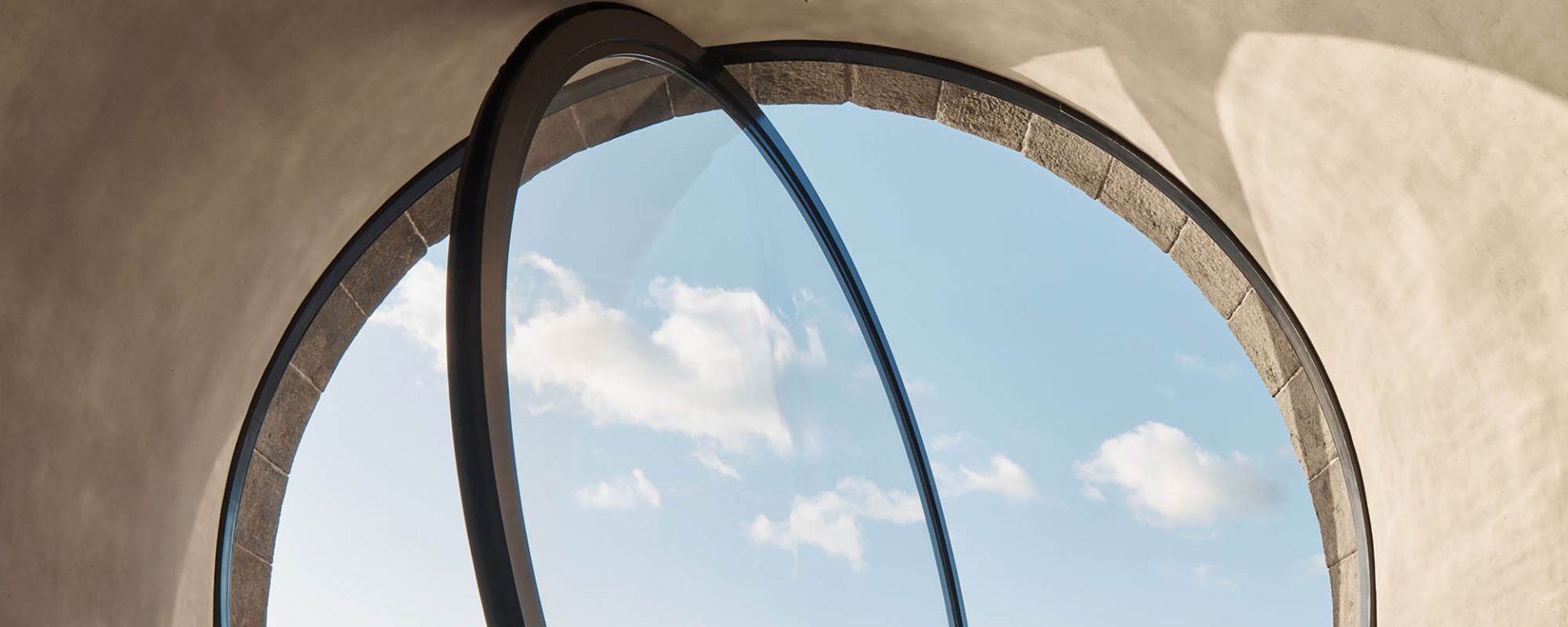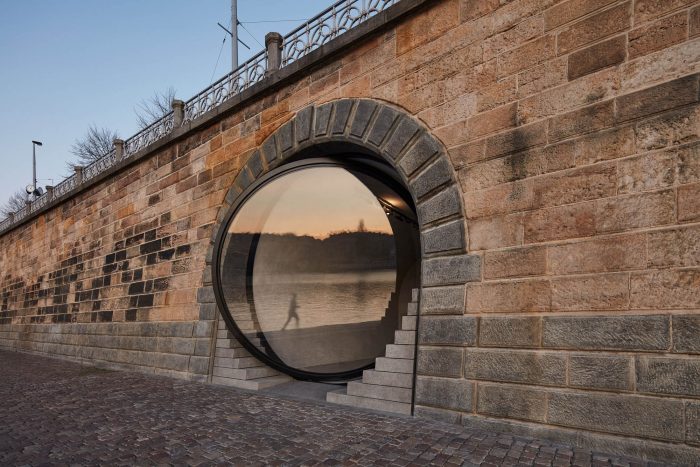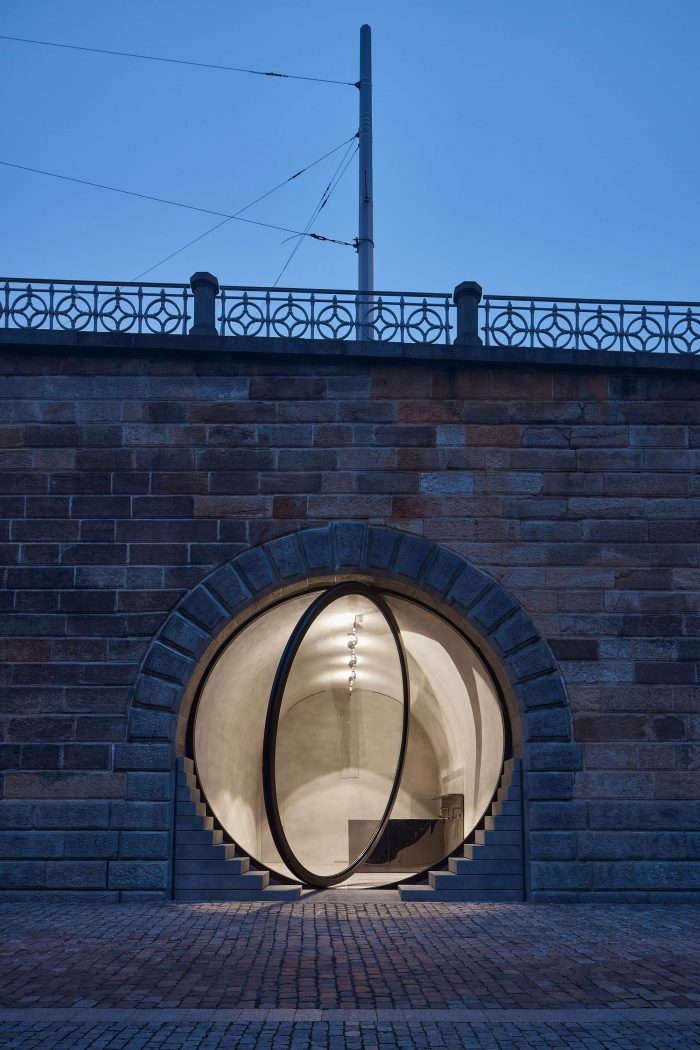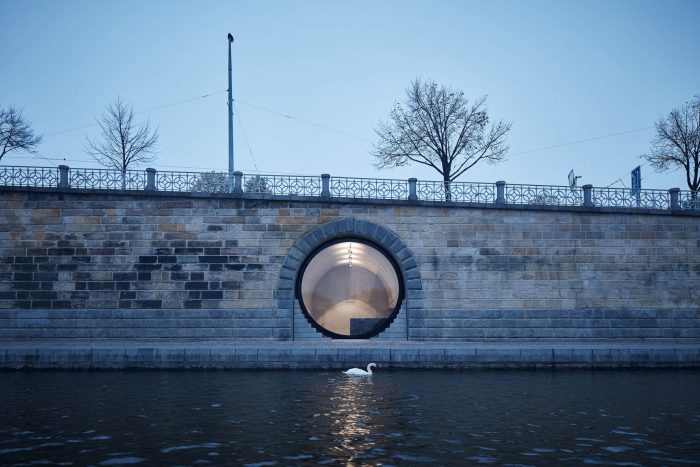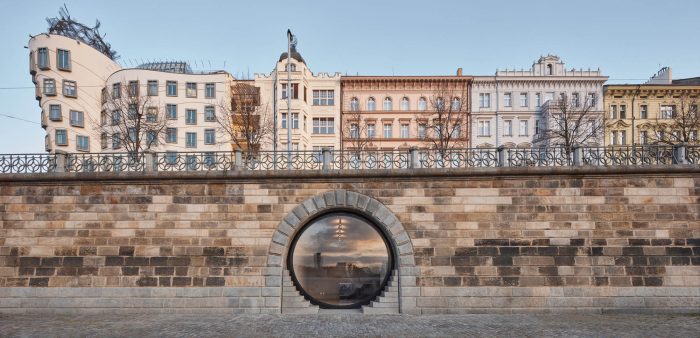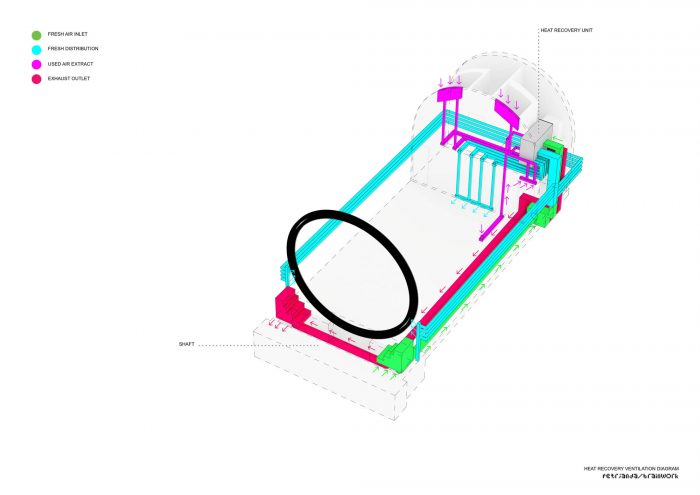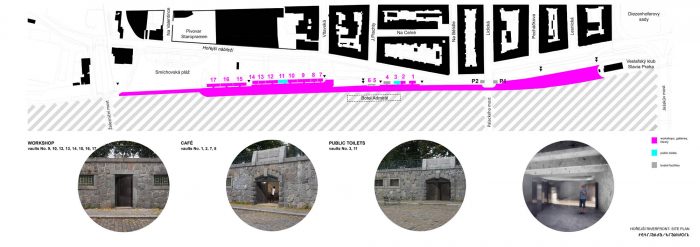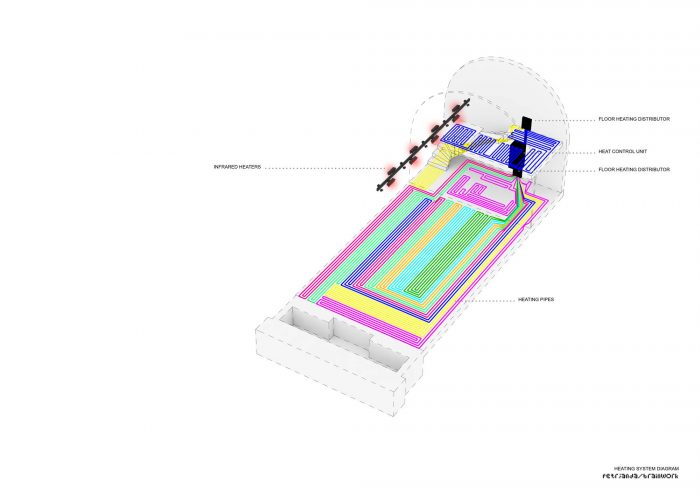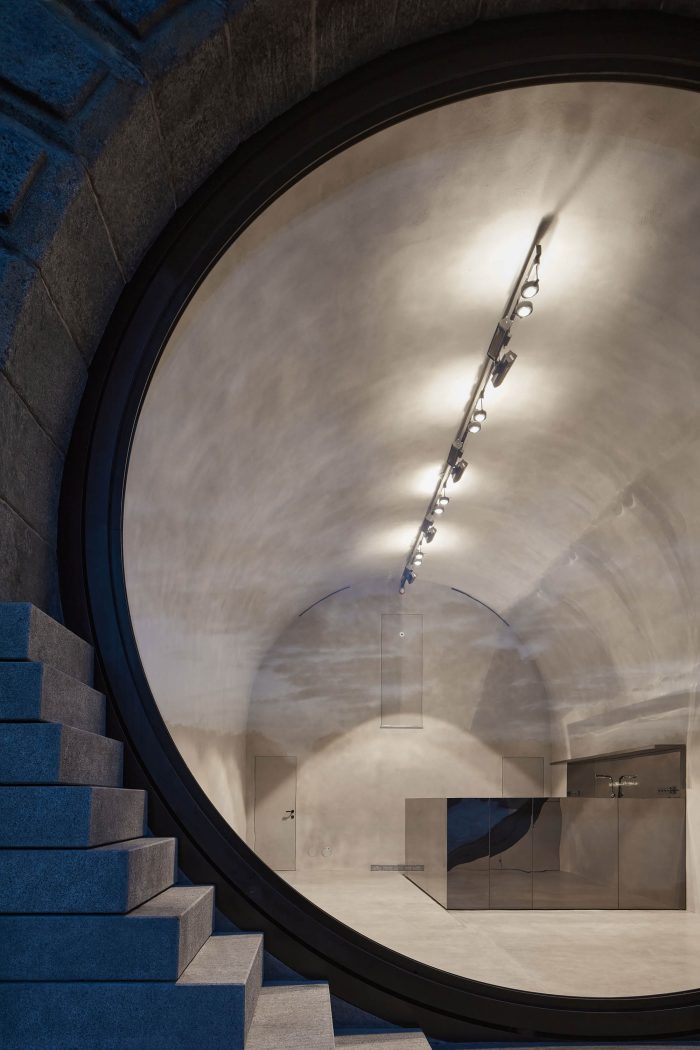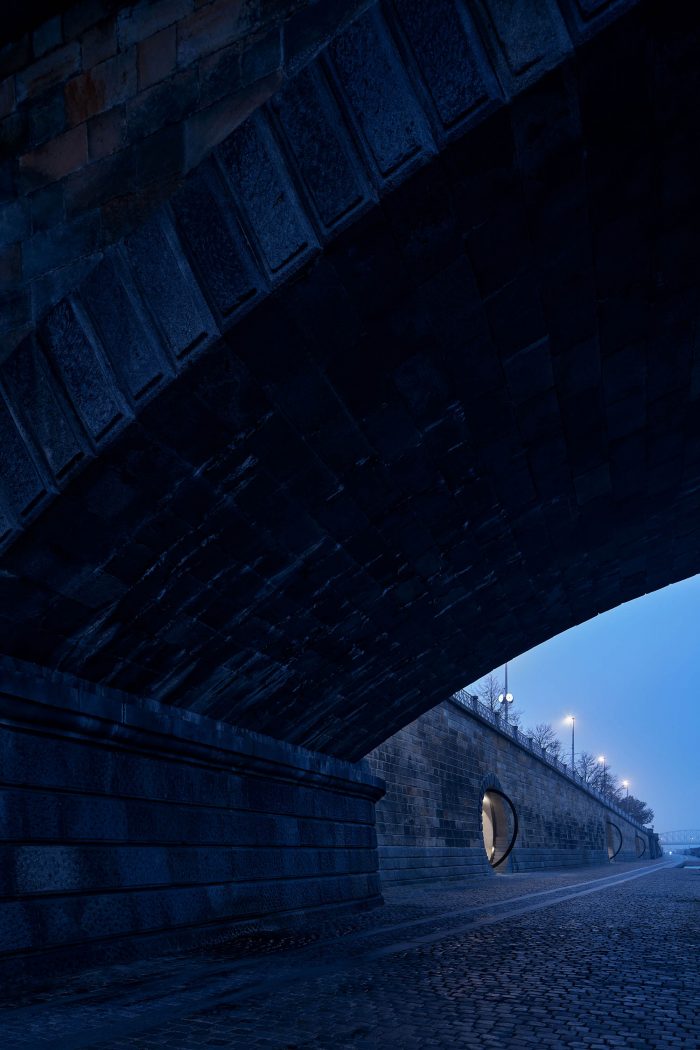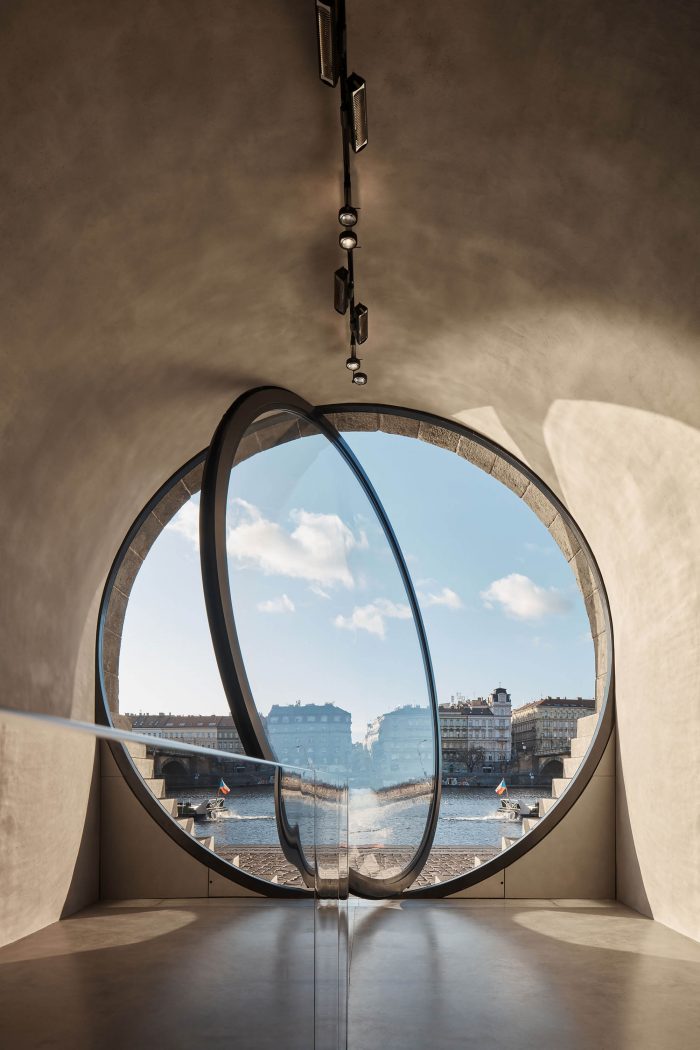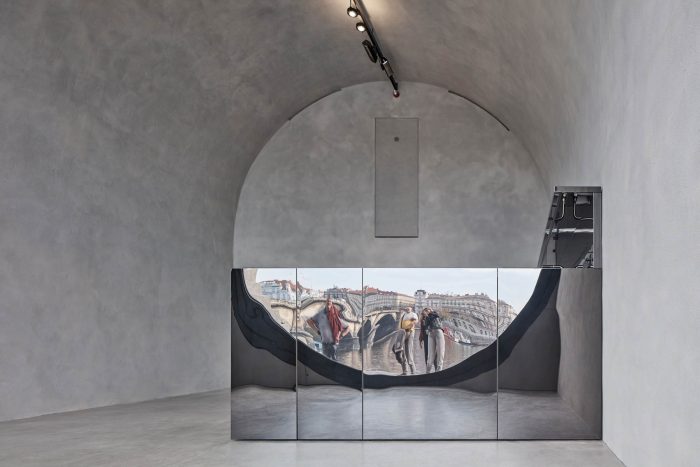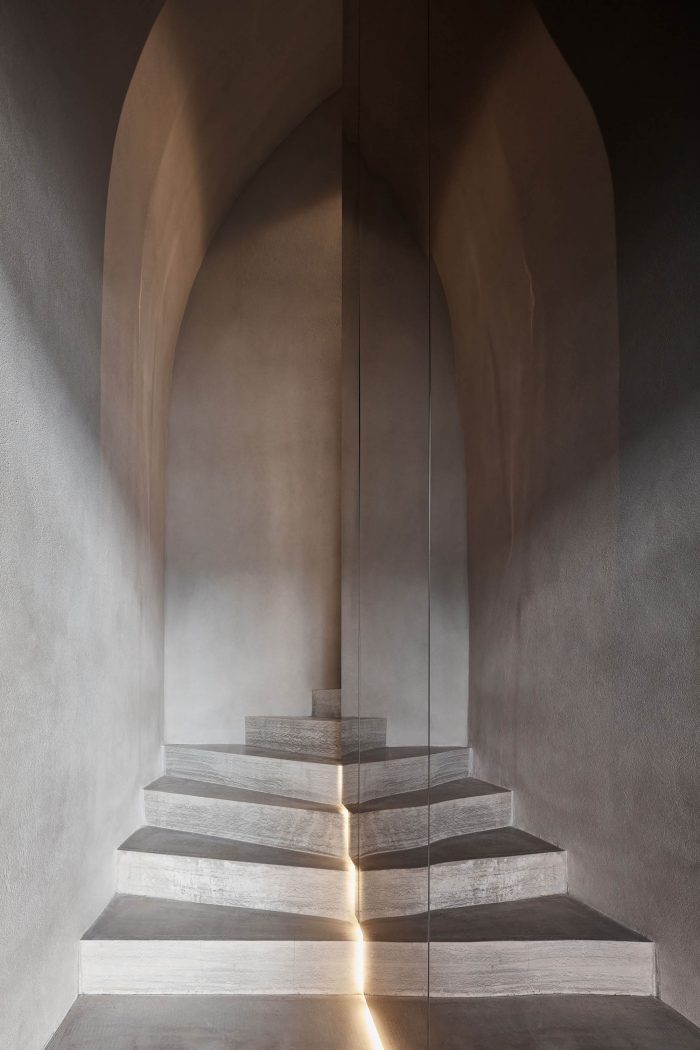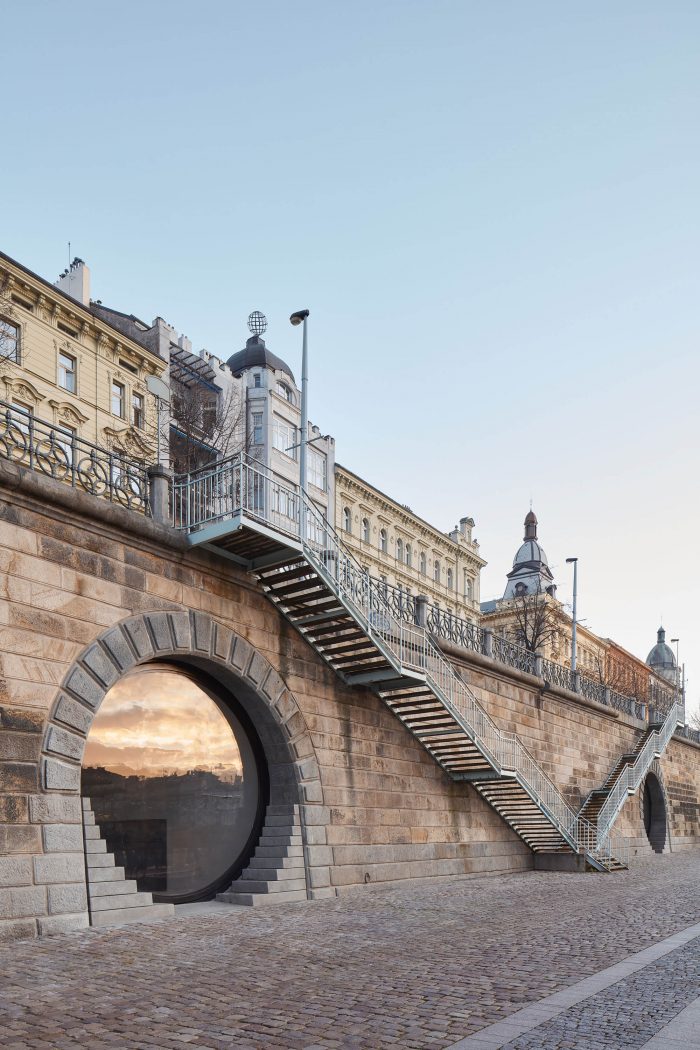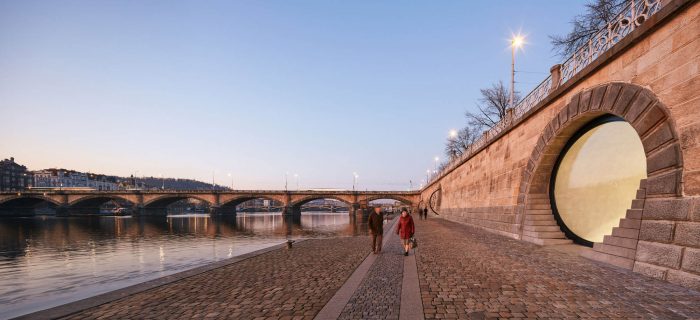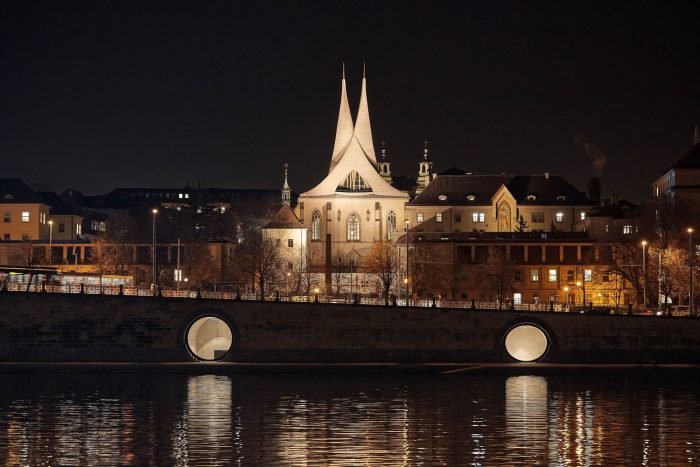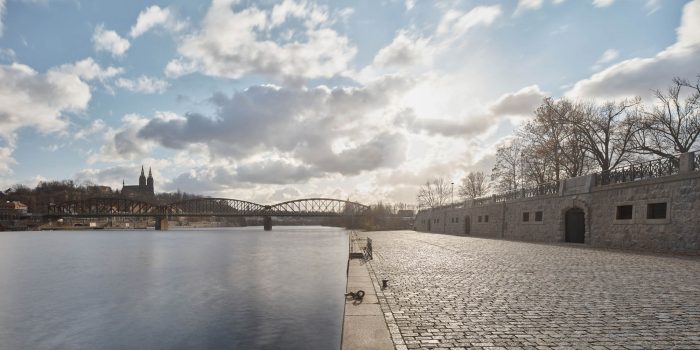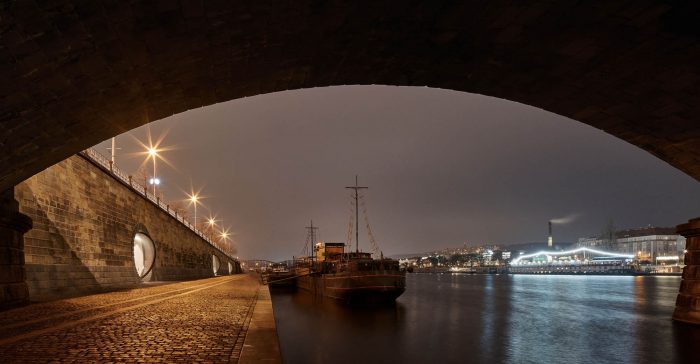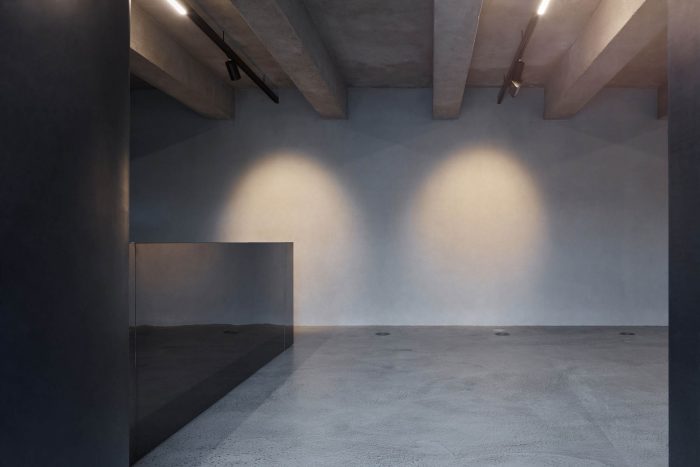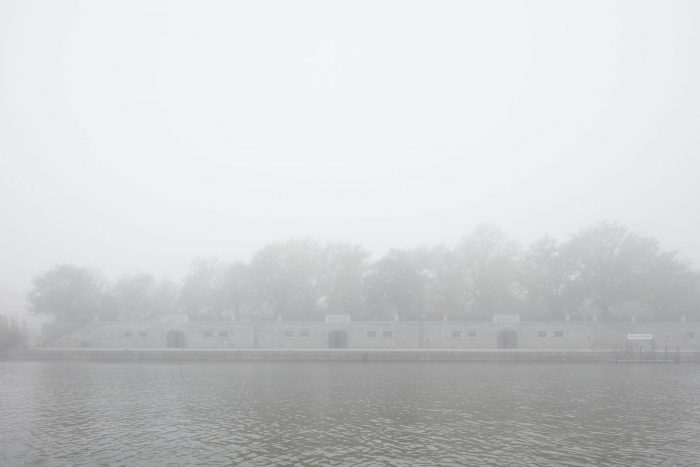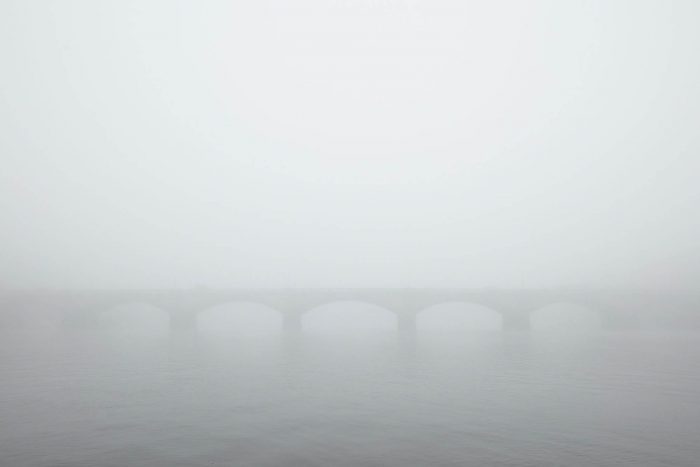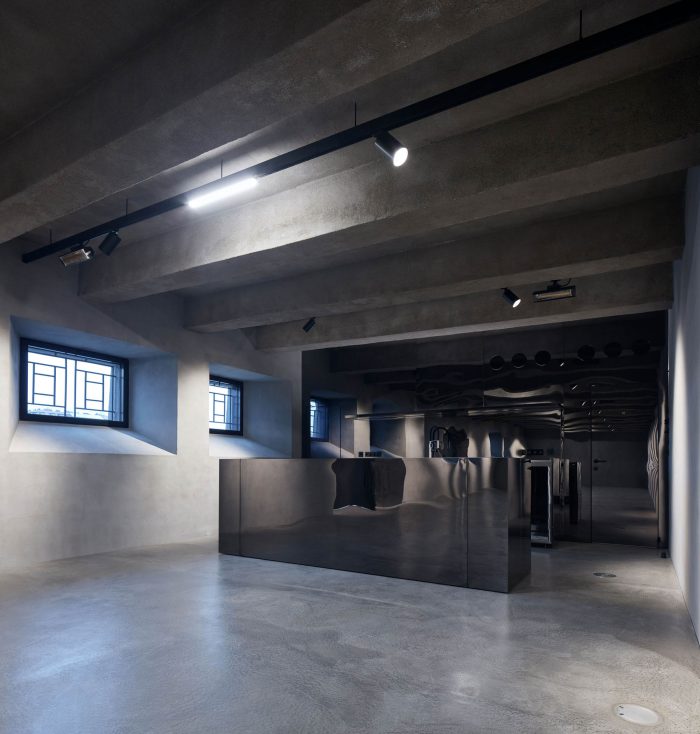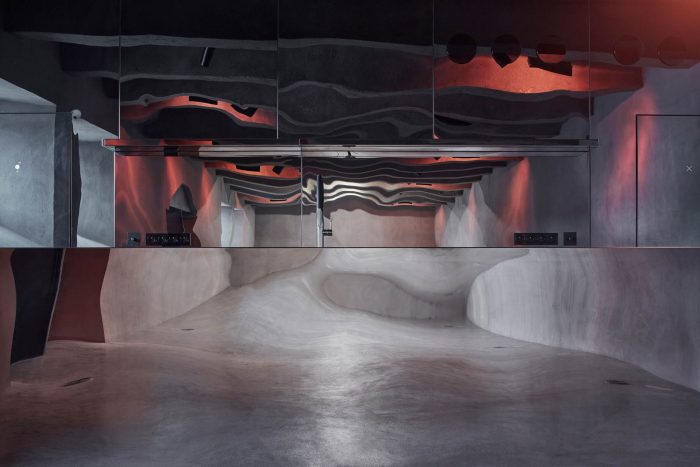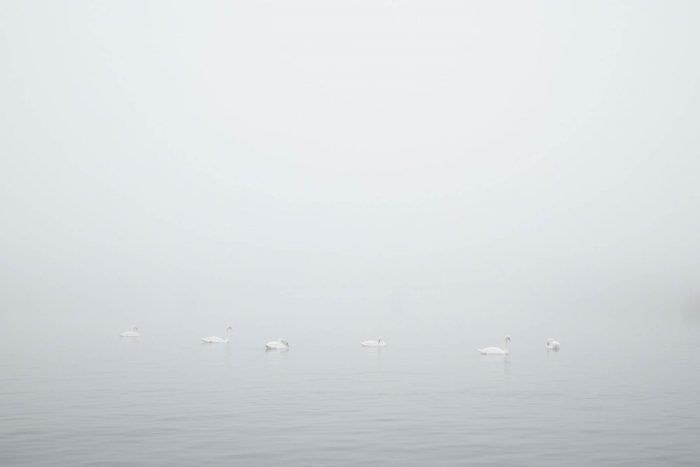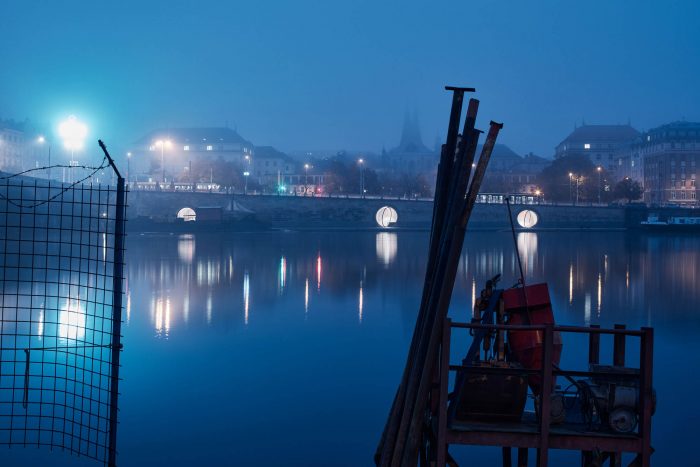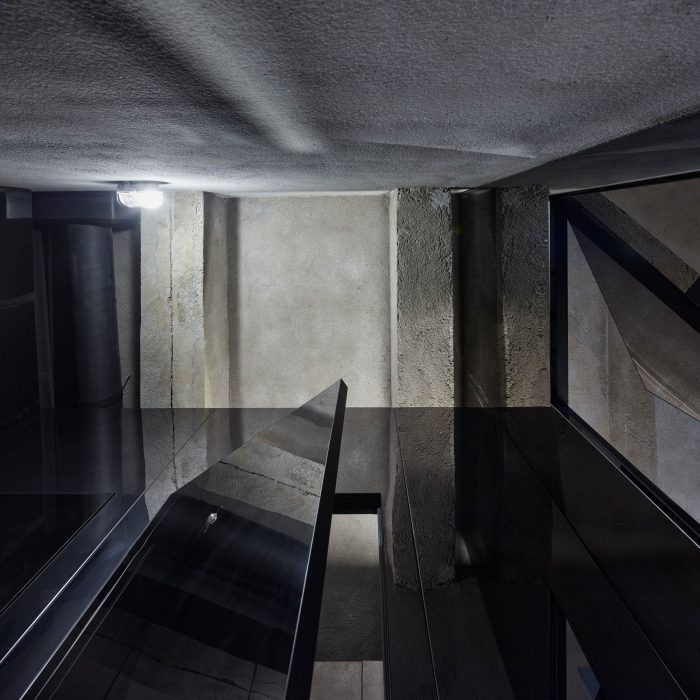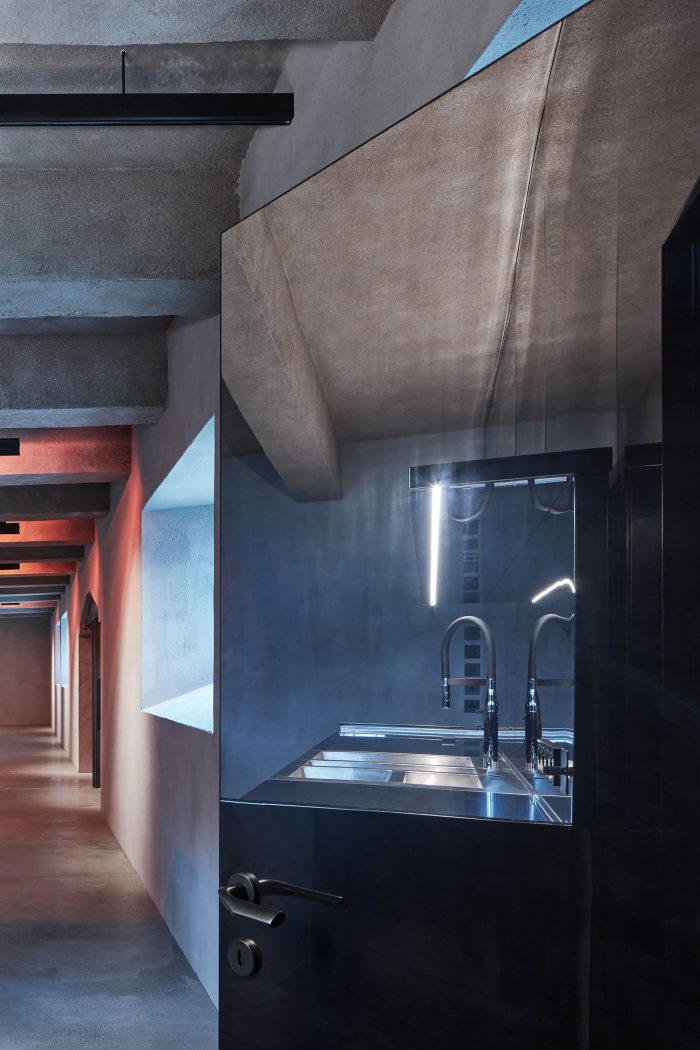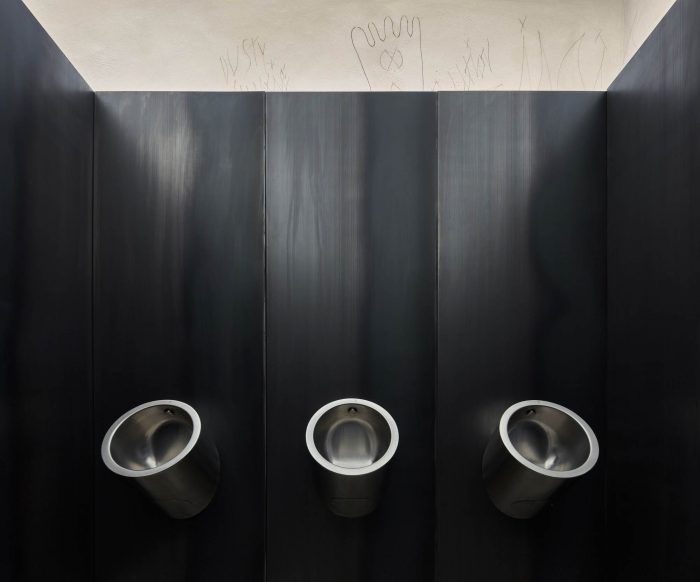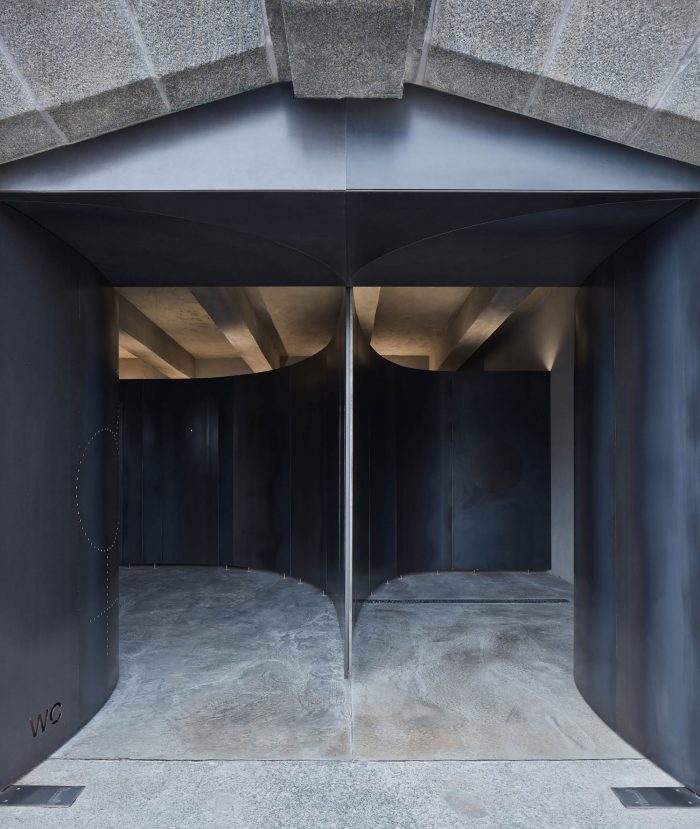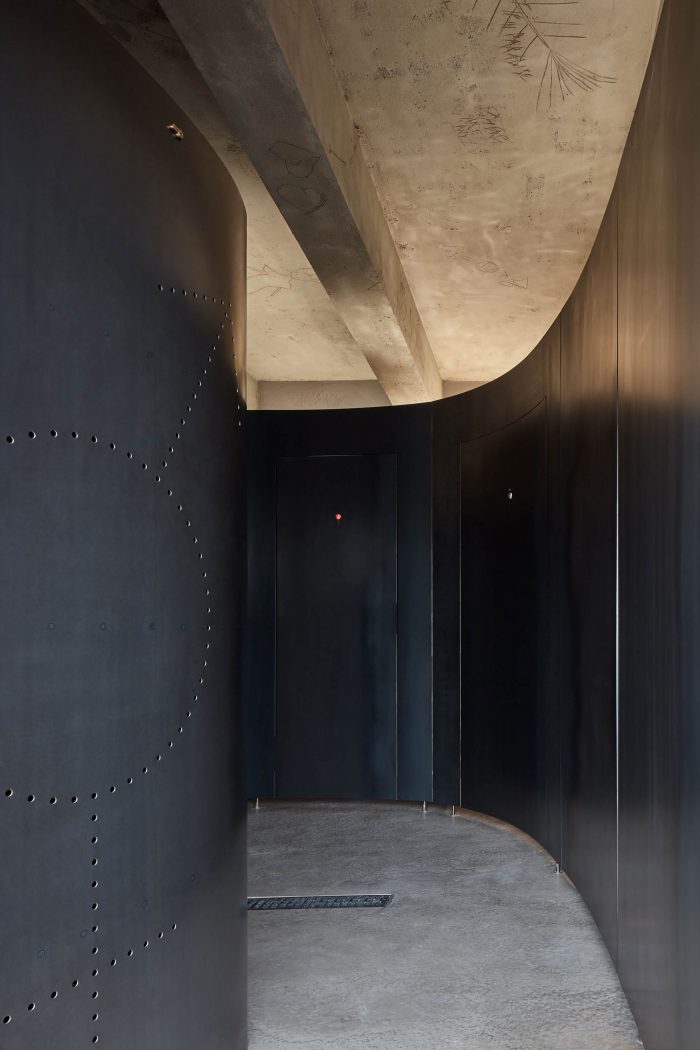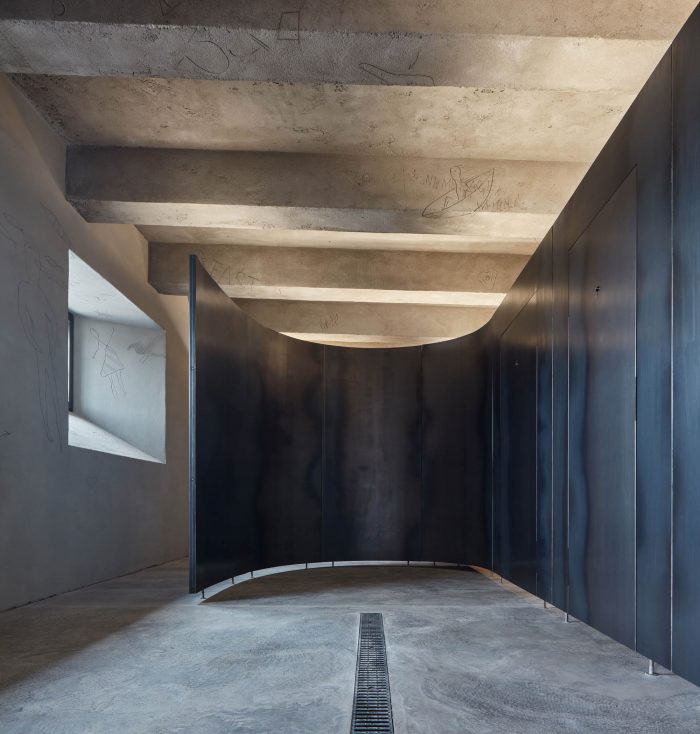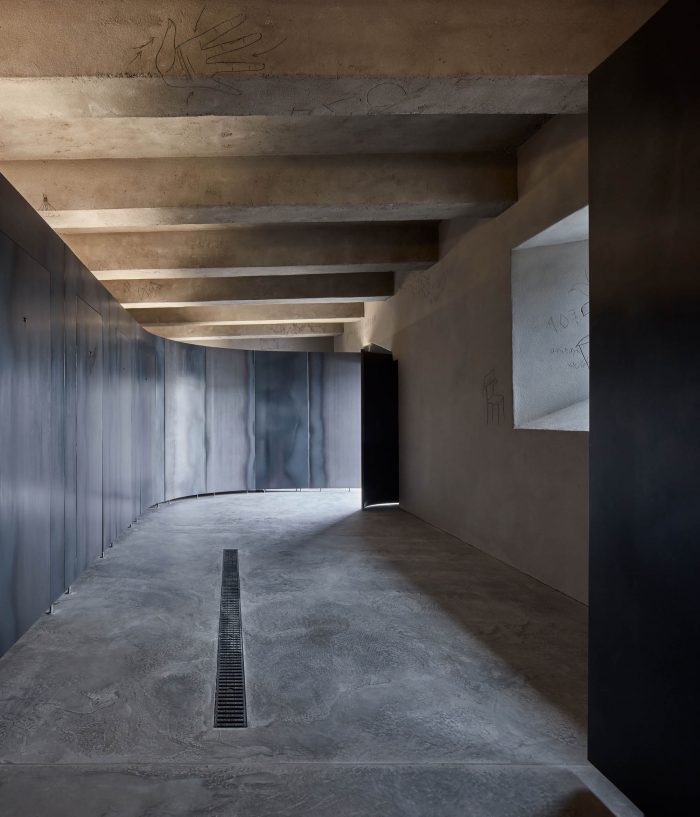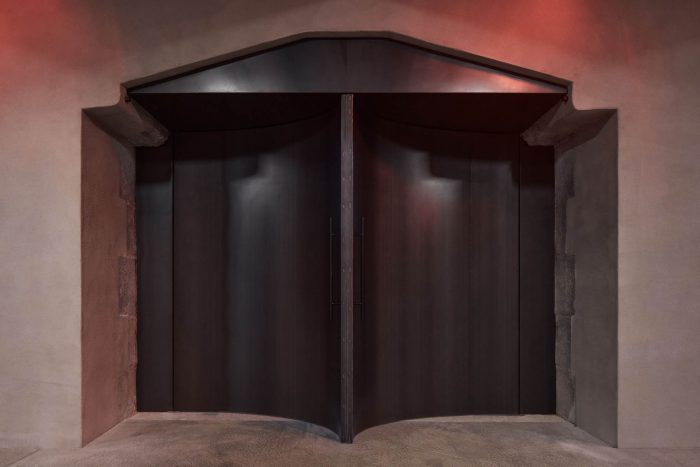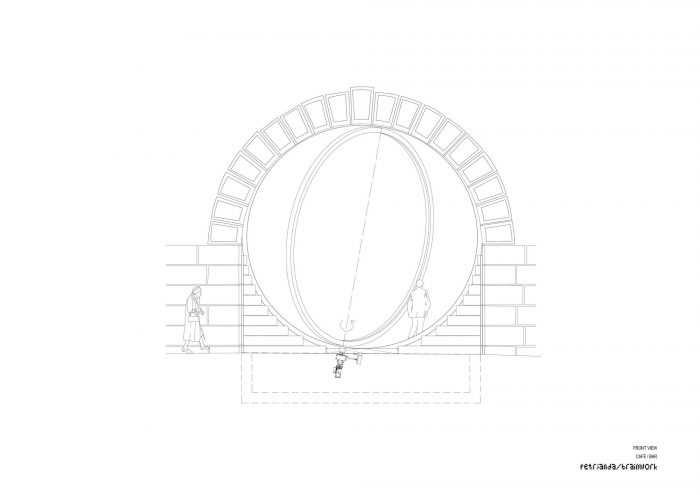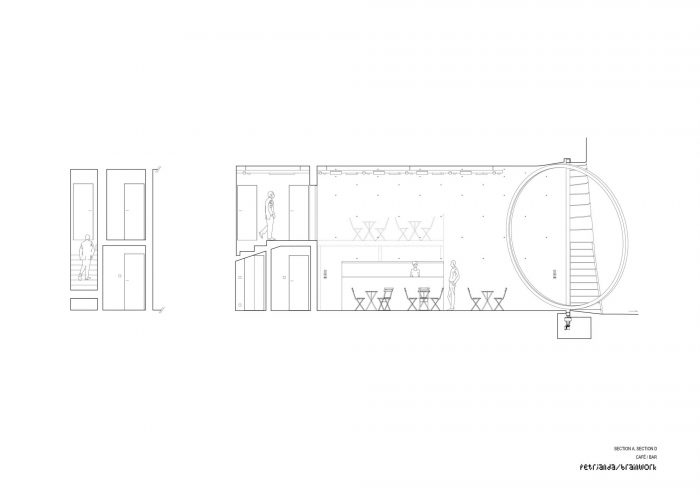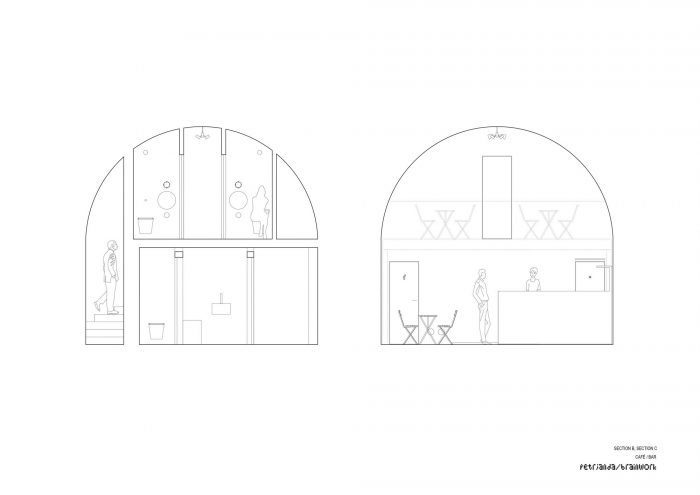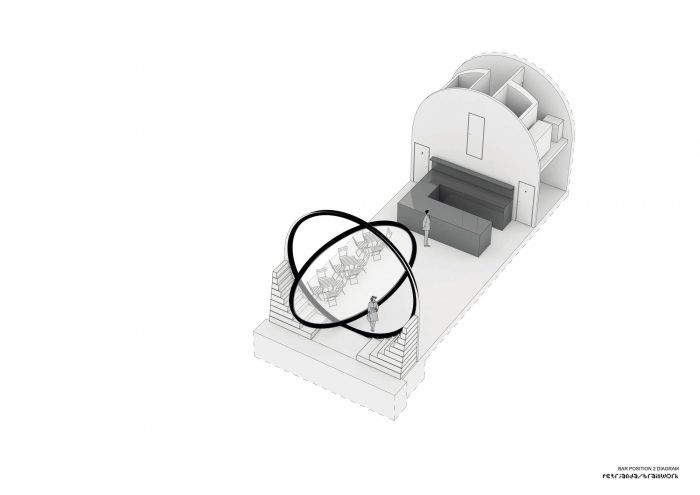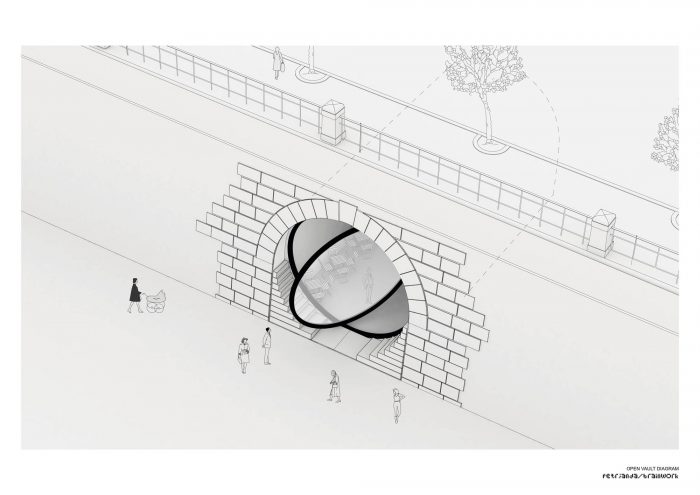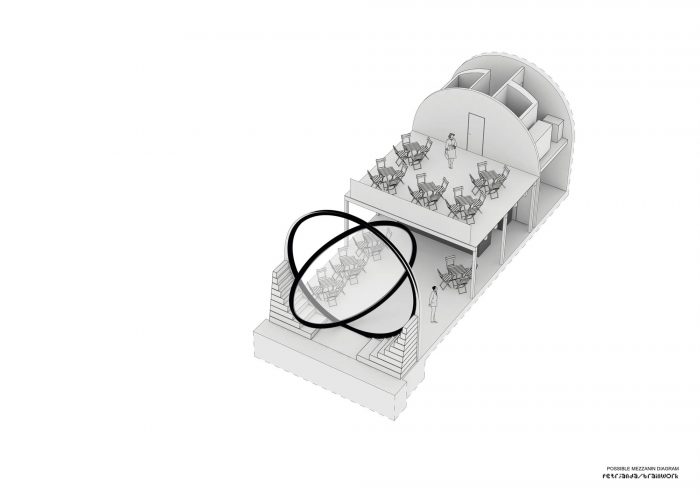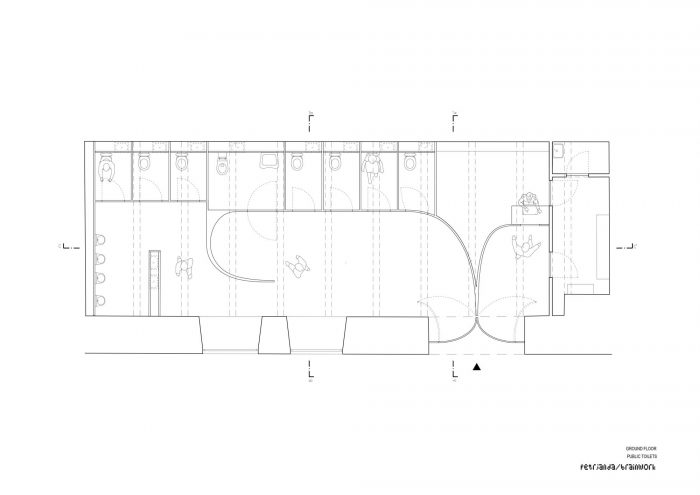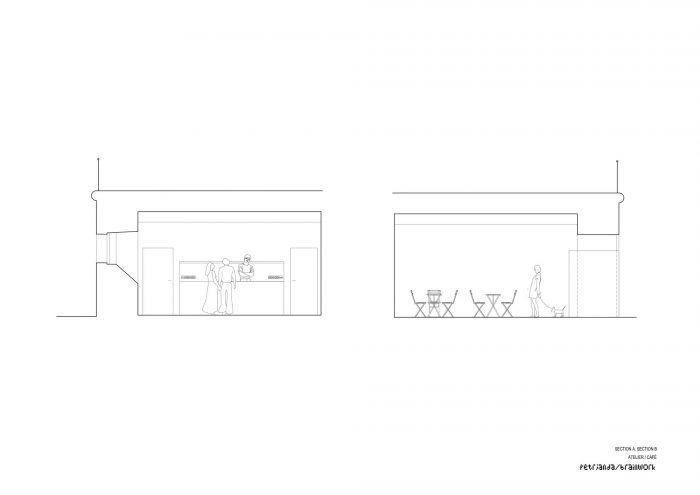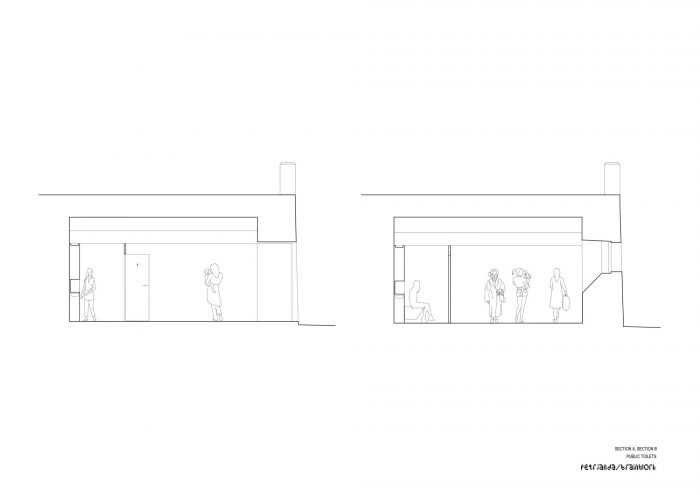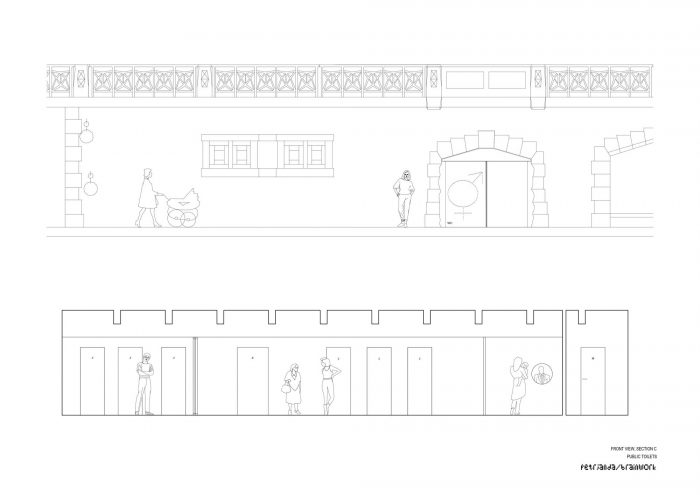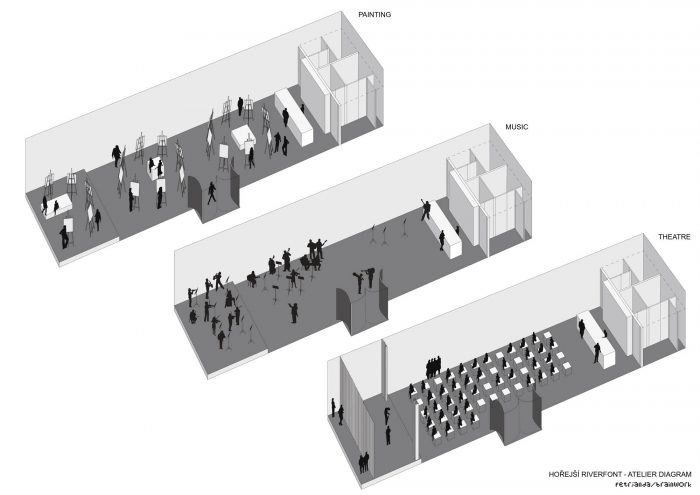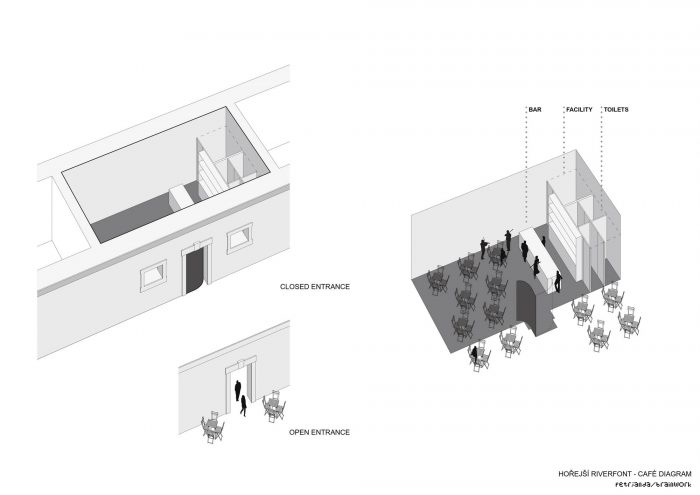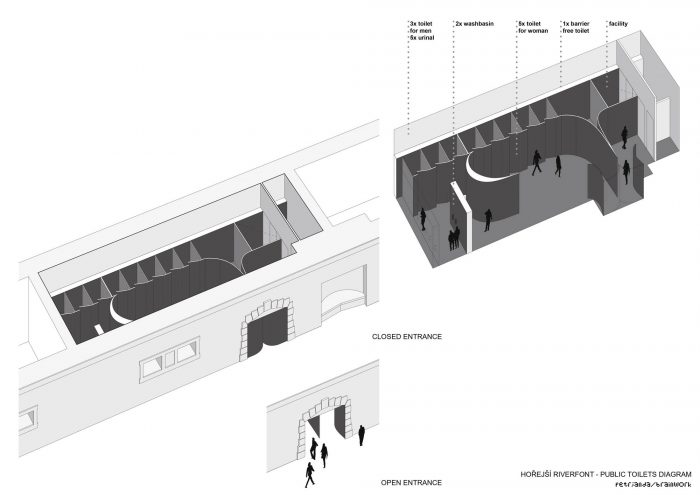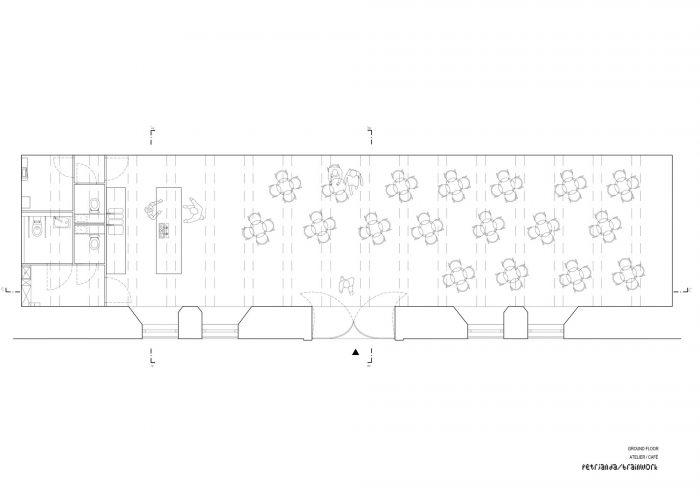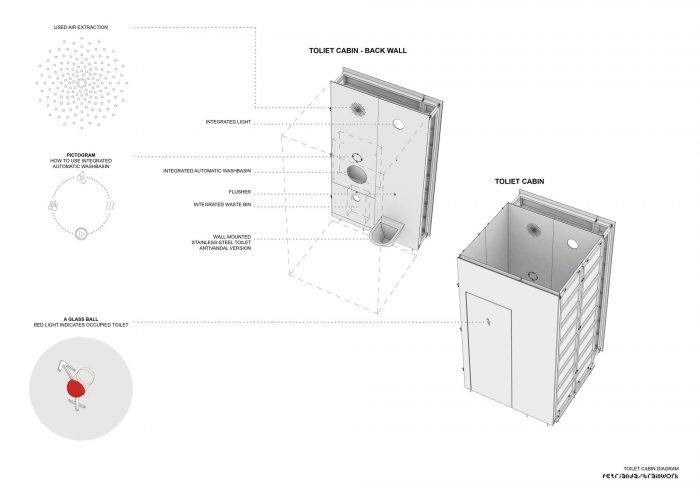这个项目已经建设了10年。我们在2009年共同发起,作为布拉格河滨地区的方案和建筑振兴,该地区被建成码头和转运点。在2002年的洪水之后,该地区被荒废,被用作停车场。通过逐步的项目激活,我们实现了文化和社会的复兴,随后又实现了建筑的修复。
城市背景
布拉格的滨河区是一个具有全城意义的公共空间,使公共空间与城市的脊髓–伏尔塔瓦河形成了独特的共生关系。在岸边规范的部分,滨河建筑成为河道脊髓的骨架,它通过堤岸的各个 “椎体”,支撑起城市的骨架系统,而构成其身体的整个城市结构就挂在这个骨架上。这个骨架不应该是僵硬的、装裱的、石化的纪念性遗迹,而应该在建筑和内容真实性的基础上,让全布拉格意义的流动和文化生活。在我们的活化中,我们启动了这一层,并在穹窿的开放和其内容之间创造了一种基于与外部独特接触的功能张力,与河流直接关系的 “灿烂的隔离 “和从堤岸的上层与城市的二次连接之间的张力。我们以一种特有的方法来处理空间细节;我们的干预措施以有意义的(感官)片段来对比,同时补充整体,就像眼睛补充脸部一样,它是它的传感器,也是它不可分割的一部分。
广阔的复兴河滨区沿着布拉格三条河堤延伸。拉辛、霍热伊希和德沃夏克,全长近4公里。已完成的一期工程是1989年革命后布拉格在公共空间的最大投资,也是第一个此类项目,具有巨大的社会文化影响。它的重点是重建河边墙壁上的20个地窖(原为冰库)。这些地窖没有采用传统的内部设计,而是与外部融为一体,最大限度地与滨河地区和河流接触。
The project has been built for 10 years. We co-initiated it in 2009 as a program and architectural revitalization of the Prague riverfront area that was built as a quay and transhipment point. The area was deserted after the 2002 floods and used as a car park. By gradual program activation, we have achieved cultural and social revival, and subsequently, architectural rehabilitation.
Urban context
Prague’s riverfront area is a public space of city-wide significance, enabling a unique symbiosis of public space with the spinal cord of the city: the Vltava River. In the regulated part of the banks, the riverfront architecture becomes the backbone for the river spinal cord, which, through the individual “vertebrae” of the embankments, holds the skeletal system of the city on which the entire urban structure forming its body is hung. This skeleton should not be stiff, mounted and petrified as a monumental relic, but should allow the flowing and cultural life of all-Prague significance based on architectural and content authenticity. In our revitalization, we initiate this layer and create a functional tension between the opening of the vaults and their content based on unique contact with the exterior, the tension between the “splendid isolation” of the immediate relationship with the river and the secondary connection to the city from the upper level of the embankment. We work with a characteristic approach to spatial detail; our interventions contrast, and at the same time, complement the whole with meaningful (sensory) fragments with the same principle as the eye complements the face; it is its sensor, as well as an integral part.
The vast revitalized riverfront area stretches along the three Prague embankments: Rašín, Hořejší and Dvořák, almost 4 km in length. The completed first phase is Prague’s largest investment in public space after the revolution in 1989, the first of this kind, and with great sociocultural impact. It focused on the reconstruction of 20 vaults in the riverside wall (originally ice storage areas). Instead of creating classic interiors, the vaults are merged with the exterior with maximum contact with the riverfront area and the river.
项目介绍
拱顶将作为咖啡馆、俱乐部、工作室、工作室、画廊、图书馆分馆、邻居会议空间和公共厕所。建筑设计采用模块化的多样性,空间被设计成一个详细的基础,包括所有的操作和技术设施以及一个可以移动到不同位置的酒吧。有一本用户手册,其中包含了各个租户的识别和内置元素的添加(将地板插入大型拱顶,外部酒吧等),强调每个拱顶的可能调整,使其通过每个租户的设备与其座位家具和内部元素获得一致的完整性。作为建筑师,我们监督各个调整,使该区域的基本视觉得到保留,同时实现每个租户的真实性。我们尽量支持租户,并在建筑上保持背景,允许不同的意见。虽然这往往意味着不同的建筑敏感度,但我们相信这将通过另一个层面补充我们的基本金库设计。大多数共同创造了滨河区现象的租户将继续在那里生活,而新的项目也是在公开的公开竞赛中从各种计划中选出来的。我們相信他們會與河濱地區形成社會配套,並提供不同的內容和項目概念,以滿足所有需求。
作为建筑活化的一部分,我们开始为滨河地区创建一个项目方法论。馆长一职的设立是为了补充管理者–建筑师–馆长的功能三角关系,由权威机构来监督这个宝贵的公共空间的文化和社会质量。
Program
The vaults will serve as cafes, clubs, studios, workshops, galleries, a library branch, space for neighbour meetings and public toilets. The architectural design works with modular diversity, the spaces are designed as a detailed base that includes all operational and technical facilities and a bar that can be moved to different positions. There is a user’s manual that contains the identification of the individual tenants and the addition of built-in elements (the insertion of floors into large vaults, exterior bar, etc.) Emphasis is placed on the possible adjustment of each of the vaults so that they gain consistent integrity through the equipment of each tenant with their seating furniture and interior elements. As architects, we supervise the individual adjustments so that the basic vision of the area is preserved, while achieving authenticity for each tenant. We try to be support for the tenants and stay in the background architecturally, allowing a diversity of opinions. Although this often means different architectural sensitivity, we believe this will complement our basic vault design through another layer. Most of the tenants who co-created the phenomenon of the riverfront area will continue there and new projects have been selected from a whole spectrum of plans in an open public competition. We believe they will socially complement the riverfront area and offer various content and program concepts that will cater to all needs.
As part of the architectural revitalization, we initiated the creation of a program methodology for the riverfront area. The position of curator was created to complement the functional triangle of manager–architect–curator, with an authority overseeing the cultural and social quality of this valuable public space.
建筑设计
干预与河边墙体的原有建筑共生融合,自然而然地融为一体;通过运用针灸策略,重新创造一个不朽的整体。目的是以最大限度的开放墙内空间,实现与滨河区域最直接的联系。建筑设计对该地的环境做出了回应,并以最小的艺术手段进行工作,允许清除现有的形状和关系,并从堤岸的环境中找到新的相互联系的观点和可能性。
拉辛河堤上的六座拱顶是按照现有开口上部几乎是圆形的弧度建造的。设计本身就是基于一个微小的干预,取之不尽用之不竭,以现代的方式将现有的品质带回来,创造了一个独特的局面和机会。原有的拉伸金属幕墙和建在滨河墙原桥拱上的石材构造被打掉,取而代之的是大规格的玻璃圆窗,通过框架内的对角旋转打开。入口门户设计为非典型的钢构架,配以重达1-1.5t的扩张椭圆玻璃。现有门户的石拱内衬,沿用以前的台阶典故,用石阶体量来完成,隐藏了安装井、空调通风口和防洪控制元件。由有机玻璃制成的椭圆旋转窗厚7cm,直径5.5m,重约2.5t。每一扇都有独特的形状,由于其尺寸超过标准玻璃,这可能是世界上最大的枢窗。开启和关闭是由发动机驱动的。对于内部空间的操作,窗户被固定在其开口的60%的位置。其他的选择是用运动检测传感器自动打开,也可以由酒吧工作人员打开。Hořejší堤岸上的十四个金库的钢制雕塑入口在门框中呈弧形,这样的方式使金库与整个空间中的滨河区域在打开后连接起来。在有公共厕所的拱顶,入口翼沿着一条平滑的弧线进入内部膜,将小屋和公共区域分开。
Architectural design
The interventions symbiotically merge with the original architecture of the riverside wall, into which they naturally fuse; by using the acupuncture strategy, they re-create a monumental whole. The aim is the most direct connection with the riverfront area with the maximum opening of the spaces inside the wall. The architectural design responds to the context of the place and works with minimal artistic means that allow purging of the existing shapes and relations and finding new interconnection views and possibilities arising from the environment of the embankment.
The six vaults on the Rašín Embankment are built following the almost circular arc of the upper part of the existing openings. The design itself is based on a tiny intervention, which takes more than it adds and brings the existing quality back in a contemporary way, creating a unique situation and opportunity. The former stretch metal curtain wall and stone constructions built into the original bridge arches of the riverfront wall were knocked down and replaced with large-format glazed round windows that open by diagonal rotation inside the frame. The entrance portals are designed as atypical steel frames with dilated elliptic glass weighing 1–1.5t. The stone arched linings of the existing portals are completed with stone stepped volumes following the former steps allusion, which hide the installation shaft, air-conditioning vent and anti-flood control elements. The elliptical pivoting windows made of organic glass 7cm thick and 5.5m in diameter weigh approximately 2.5t. Each has a unique shape and, due to their size exceeding the standard glazing, these are probably the largest pivot windows in the world. Opening and closing is engine powered. For the operation of the inner spaces, the windows are fixed in the position of 60% of its opening. Other options are automatic opening with motion-detecting sensors, or they can be opened by the bar staff. The fourteen vaults on the Hořejší Embankment have steel sculptural entrances curved into the jamb in such a way that they connect the vault with the riverfront area in the entire space when opened. In the vaults with public toilets, the entrance wings follow a smooth arc into the interior membrane separating the cabins from the public area.
结构和材料
在重建过程中,包括楼层在内的所有内置构件都被拆除,并采用将新建筑插入原有空间的方法建造。制作了带抽水井的防洪钢筋底板,修复了渗水问题,并在承重钢筋上用Torcreted混凝土对墙体进行了保温和饰面,巩固了卷式拱顶的几何形状。内置的隔断是整体钢筋混凝土隔断,带有插入式装置。拱顶的各个元素的设计和材料是统一的,适用于所有类型的空间。墙面和天花板的表面设计为喷砂混凝土,地面为现浇混凝土,楼梯为现浇整体式。舱口和门的表面与墙面和地面的相邻表面相对应(喷砂混凝土和现浇混凝土,公共厕所拱顶采用浸渍黑钢)。门是无回扣的,有隐藏的自动关闭装置。在拱顶空间,表面插入了用于悬挂展览的内置插件。栏杆和隔断的插入部分由黑色钛涂层不锈钢板包覆,通过反射与拱顶的空间几何形状相得益彰,并通过反射的不断波动运动,将河流的流动不解带入室内。照明设计利用公厕内的灯光坡道作为间接照明,嵌入钢墙内,天花板上的灯光反射。
技术设计
地暖与空调的结合,带热回收和红外线加热器,可以实现全年运行,所以可以全年开窗与滨河区相连。所有的工程分布都与拱顶结构融为一体,不影响视觉设计。在拉辛堤上,空调有非典型的缝隙插入到门户楼梯连接处和内槽中;而在霍热伊希堤上,空调则插入到地板和墙面的窗户卡口和出口中。电气安装插座、水和下水道都隐藏在内置的圆柱形楼板箱中。地下室是无障碍的,由便携式防洪挡板保护。所有的空间都使用模块化、设备齐全的小屋,包括壁挂式不锈钢马桶、定制的自动洗脸盆和干手器、照明、垃圾桶和风扇。厕所门上有一个非典型的灯光占用指示灯,设计成一个玻璃球,上面有一个象形图案(男、女或男女通用)。整个污水清除系统采用压力泵系统,将污水抽入位于堤岸以上的污水管。
Structure and materials
During the reconstruction, all built-in elements, including floors, were demolished and built using a method of insertion of the new building into the original space. Flood control reinforced base slabs with pumping sumps were made, water infiltration was repaired and walls were insulated and finished with torcreted concrete on load-bearing reinforcements, consolidating the geometry of rolled vaults. The built-in partitions were concreted as monolithic reinforced concrete ones with inserted installations. The design and materials of the individual elements of the vaults are unified for all types of spaces. The surfaces of the walls and ceilings are designed as sandblasted concrete with a cast concrete floor and a cast monolithic staircase. The hatches and doors are finished with surfaces corresponding to the adjoining surfaces of the walls and floors (sandblasted and cast concrete and impregnated black steel in the public toilet vaults). The doors are non-rebated with hidden self-closing devices. In the vaulted spaces, built-in inserts for hanging exhibitions are inserted into the surfaces. The inserted parts of bars and partitions are clad in black titanium-coated stainless-steel plate, complementing through reflection the spatial geometry of the vaults, and through the constant volatile movement of the reflection, bringing the fluid incomprehensibility of the river inside. The lighting is designed using light ramps in the public toilets as indirect lighting embedded in a steel wall with light reflection from the ceiling.
Technical design
A combination of floor heating with air-conditioning with heat recovery and infrared heaters allows year-round operation, so it can be connected with the riverfront area with the windows open all year. All of the engineering distributions are integrated into the vault structures so that they do not interfere with the visual design. The air conditioning has atypical slits inserted into the portal staircase joints and inner slots on the Rašín Embankment; whereas on the Hořejší Embankment, it is inserted into the window jambs and outlets in the floor and walls. The electrical installation outlets, water and sewerage are hidden in built-in cylindrical floor boxes. The vaults are barrier-free, protected by portable flood-stop barriers. All of the spaces use modular, fully-equipped cabins that include wall-mounted stainless-steel toilets, custom-made, automatic washbasins with hand dryers, lighting, waste bin and fan. The toilet doors have atypical light occupancy indicators designed as a glass ball with a pictogram (men, women or unisex). The entire sewerage removal system works as a pressure pumping system, which pumps the sewage into the sewer mains located above the level of the embankment.
正在进行的阶段
正在进行的下一阶段振兴工作包括设计街道设施(地下垃圾箱、饮水机、长椅)、独立式厕所、浮动水池、游船浮动码头和浮动厕所,以及照明系统。剩下的几个库房和基础设施网络正在重建中。需要解决的一个问题是减少停靠在河岸上的船只和浮动设施,并将这些船只和浮动设施安置在河岸上,使其不妨碍新开放的金库与河道的接触。将会有一个重新的安排和减少,这应该反映出漂浮设施在类型、建筑性质和程序价值方面的定性贡献和放置逻辑,优先选择低矮的甲板,使其能够看到河道和文化内容,不通过定量出售茶点寄生于河边的商业开发。
使滨河区岸边得以清理的重要因素之一,是未来游船的浮动码头,它将把登船集中到一个中心。漂浮池恢复了布拉格传统的河水浴场,是一个与该地区历史有重要关系的元素。
Ongoing phases
The next phases of the ongoing revitalization include design of the street furniture (underground litter bins, drinking fountains, benches), free-standing toilets, floating pool, floating terminal for cruise boats and floating toilets, as well as a lighting system. The remaining few vaults and infrastructure networking are now being reconstructed. One issue to be addressed is a reduction in boats and floating facilities anchored to the river bank and situating these so they do not obstruct the contact between the newly opened vaults and the river. There will be a rearrangement and a reduction, which should reflect the qualitative contribution and logic of placing the floating facility with respect to the value of its type, architectural nature and program, with preference for low decks allowing a view of the river and cultural content that does not parasitize the riverfront commercial exploitation through the quantitative sale of refreshments.
One of the important elements enabling the clearing of the bank edge of the riverfront area is a future floating terminal for cruise boats, which will concentrate the boarding of boats into one epicentre. The floating pool, restoring the Prague tradition of river baths, is an element with a significant relationship to the history of the area.
建筑师:PETRJANDABRAINWORK
年份:2017年
摄影作品:BOYSPLAYNICE
城市: 布拉格
国家:捷克
Architects: PETRJANDABRAINWORK
Year:2017
Photographs: BOYSPLAYNICE
City: PRAGUE
Country: CZECHIA

